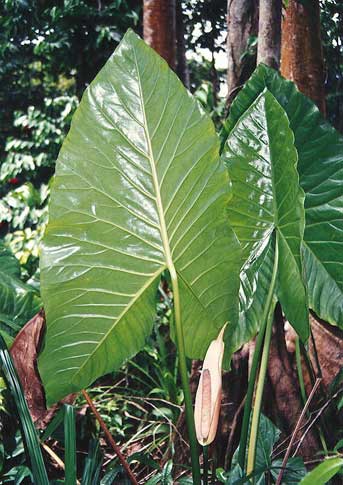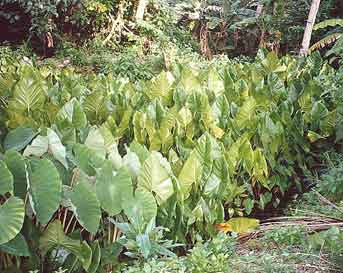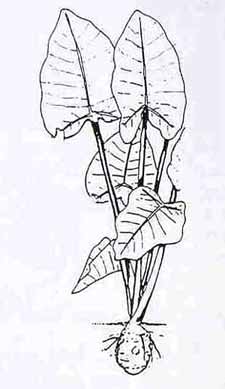 Iaraj (Crytosperma chamissonis) leaf and flowering parts
Iaraj (Crytosperma chamissonis) leaf and flowering parts |
Description: This large, cultivated "hard" or "swamp" taro has been a very important starchy, staple food source. It reaches heights up to 4-6 m (15-20 ft) and produces huge green to yellowish-green, heart-shaped leaves with tips that point upward.
Distribution: Iaraj is an aroid "root crop" species probably native to Southeast Asia or wetern Melanesia. Early settlers brought it by canoe to many islands of the tropical Pacific, including the Marshall Islands, in prehistoric times.

Kōtak (Colocasia esculenta) is shown being cultivated on the edge of an excavated swamp pit in the lower left foreground and Iaraj (Crytosperma chamissonis) is shown in the pit itself, with its main leaf tips pointing upward.
|
Uses: It is cultivated for its swollen, starch-rich, underground parts in man-made, muck-filled, freshwater swamps (pits dug down to the freshwater table). Five varieties of this food crop plant have been recorded in the Marshall Islands. Weeds are usually shaded out of iaraj patches, because its very large leaves grow close together. Leaves of iaraj are used to wrap taro food cooked in the um (oven). Iaraj may be harvested any time of year. Men do the heavy work and women do the weeding. The plant is not seasonal, and thus there is no tribute presented to the irooj (chief) from the first harvest. However, when one gathers iaraj for a special occasion such as a birthday feast, the irooj is provided a portion of the harvest.
Iaraj is prepared with other staple foods in the following combinations:
1.Wūdeñ - with cooked and pounded breadfruit, taro, bananas or nuts mixed with grated coconut
2. Jebwater - food with grated taro mixed with coconut milk, wrapped in taro leaves and baked in oven
3. Totaimon - food with taro grated and mixed with coconut oil and coconut sap
4. Kōmālij - mashed taro or potato
5. Jukjuk - pounded taro mixed with coconut |

|

